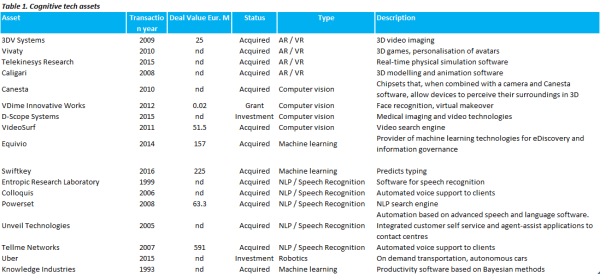Microsoft is Becoming M(ai)crosoft
This post is an overview and discussion of Microsoft's increasing investment in, and approach to, artificial intelligence, and how their philosophy differs from their competitors.
By Peter Zhegin, Flint Capital, and Daniel Kornev, Zet Universe, Inc.
Tech giants are active players at the cognitive technologies scene. Alphabet and Facebook proved themselves active acquirers and investors in cognitive tech. Supercomputers, robots and drones are among themes approached by Internet giants.
Microsoft, however, seems to be following a differed path: it integrates cognitive technologies into traditional products and makes them smarter.
Bill Gates coined the concept of ‘digital nervous system (DNS)... that ... [provides] a well-integrated flow of information to the right part of the organization at the right time’. This intellectual system inherits some important features of its biological prototype, for instance, it ‘...blocks out the information that isn’t important ...’ [1] The system acts as an agent, anticipating user’s intentions and making some decisions by its own.
Recent Microsoft’s efforts in cognitive technologies follow the path, once highlighted by the DNS concept.For instance, at the recent Build Conference, Microsoft highlighted ‘conversational’ interface, aiming to facilitate information overload, users face[2].

Through the internal research and development as well as acquisitions and investments, Microsoft makes its software smarter. At least five cognitive technologies were explored and integrated into Microsoft’s products, namely:
- Machine Learning is a key element of Priorities and Notification platform as well as Adaptive Interface;
- Speech Recognition was pioneered since 90s, shipped as part of OS since Windows XP, then cloud-powered and currently available as a part of Cognitive Services (Project Oxford);
- Natural Language Processing (NLP) efforts in spelling, syntax, and other areas allowed to form own platform for NLP in Office and to develop Bing/Cognitive Services APIs;
- MS has been working on Knowledge Graphs since 2007, it built an ontology of the everyday things in early 2008;
- Computer Vision efforts led to Bing’s Lenses, Office Lenses in Windows Phone and iOS, as well to Kinect and the recently available AR headset, HoloLens. Computer vision also may become a part of a digital assistant, enabling it to describe the world around[5].
Microsoft’s broad interests in cognitive technologies are reflected in its investments and acquisitions. Pitchbook’s database allows identifying at least seventeen transactions by Microsoft, related to purchasing or investing in the cognitive tech assets (See Table 1).
Perhaps, the first acquisition aiming to add an AI component into the firm’s software was made in 1993, when Knowledge Industries was purchased. Its CEO Eric Horvitz, spearheaded Adaptive Systems and Interactions (ASI) group at Microsoft Research. Acquired technologies were adopted, among other things in ‘Clippy’, an office assistant, prototypes of Notification Platform[6] and adaptive interface of MS Office[7].
Microsoft improved its positions in speech recognition, natural language processing and knowledge graphs via acquisitions of Tellme Networks and Powerset for €591M and €63M respectively. Tellme’s products among other things allowed voice search quires[8], while Powerset brought the additional natural language search capabilities on the table and helped to improve Bing[9].
Later, the company acquired Equivio, that allows users ‘…to explore large, unstructured sets of data and quickly find what is relevant’[10]. Recently, Swiftkey, a predictive keyboard software, was acquired for €225M.
Computer vision has been an important field for Microsoft as well. Four transactions took place in a computer vision, including a notable acquisition of VideoSurf with its video search capabilities.
Probably, in order to improve the ecosystem around the digital agent, the company committed ~€380M to purchasing productivity solutions like Acompli (Outlook) or Wunderkinder, the maker of Wunderlist (See Table 2).
On top of developing cognitive technologies assets, Microsoft made a push into the infrastructure required to deal with its critical element — data. The company amassed assets that allow collecting data from diverse types of sources and storage (See Table 3).
For example, €761M acquisition of Fast Search & Transfer delivered to Microsoft a ‘…flexible and scalable integrated technology platform and personalized portal [that] connects users, regardless of medium, to the relevant information they need[11].
In addition to developing the infrastructure, Microsoft has allowed developers to benefit from it. The company has opened access to 22 API’s via Cortana Intelligence Suit[12] and presented Power BI Embedded, a tool for in-app data visualization[13].
Reflecting on Microsoft’s endeavors, one may make several takeaways.
- Applying a technology into a good product seems challenging even for a leading tech company. After limited success of Clippy, Notifications Management Platform at Windows Longhorn and WinFS[14] Microsoft went dark on its cognitive tech research. Only few prototypes were presented at Microsoft Research Summits and PDC conferences (e.g. MyLifeBits[15], LifeBrowser[16], Situated Interaction — MSR Receptionist[17] and Microsoft Semantic Engine[18]);
- Critical elements of cognitive tech infrastructure may be almost hidden from the public. For instance, Microsoft Semantic Engine has not received much media attention. However, it allowed users to search private and public data via natural language requests, e.g. ‘show me photos I’ve made in Greece last year’ or ‘tell me about Tom Cruise’[19];
- Long-term vision allows coupling R&D with investment activity. Microsoft has pioneered research in cognitive tech and was among the earliest acquirers at the emerging field;
- Microsoft seems to be very serious about the digital agent and smart software. These may become the next chapter for the company and an important milestone of the AI development.
References:
[1] Bill Gates, ‘Business at the Speed of Thought: Succeeding in the Digital Economy’, 1999.
[2] http://thenextweb.com/microsoft/2016/03/31/everything-microsoft-announced-build-2016-day-2/
[3] http://www.theverge.com/2016/3/30/11317924/microsoft-event-news-recap-hololens-windows-10-build-2016
[4] http://www.theverge.com/2015/1/28/7932751/bill-gates-microsoft-personal-agent
[5] E.g. https://www.captionbot.ai/
[6] http://www.nytimes.com/library/tech/00/07/biztech/articles/17lab.html
[7] http://www.eecs.harvard.edu/~kgajos/papers/2008/kgajos-chi08-predictability.pdf
[8] http://www.cnet.com/news/microsoft-buys-speech-recognition-company-tellme/
[9] http://venturebeat.com/2007/02/08/powersets-search-technology-scoop-may-scare-google/
[10] http://blogs.microsoft.com/blog/2015/01/20/microsoft-acquires-equivio-provider-machine-learning-powered-compliance-solutions/
[11] https://news.microsoft.com/2008/01/08/microsoft-announces-offer-to-acquire-fast-search-transfer/
[12] http://www.theverge.com/2016/3/30/11317924/microsoft-event-news-recap-hololens-windows-10-build-2016
[13] http://thenextweb.com/microsoft/2016/03/31/everything-microsoft-announced-build-2016-day-2/
[14] http://www.zdnet.com/article/bill-gates-biggest-microsoft-product-regret-winfs/
[15] http://research.microsoft.com/en-us/projects/mylifebits/mylifebitsdemo.aspx
[16] http://research.microsoft.com/apps/video/default.aspx?id=159531
[17] https://blogs.msdn.microsoft.com/semantics/2009/02/25/msr-techfest-2009/
[18] http://sqlblog.com/blogs/jamie_thomson/archive/2009/10/19/microsoft-semantic-engine.aspx
[19] Based on: Daniel Kornev, ‘Search and Semantic Revolution of XXI Century’.
Bios:
Peter Zhegin is an Associate at Flint Capital, an international venture capital fund investing across US, Israel and Europe. Peter is executing investments in B2B software and fintech. Prior to joining the fund, Peter worked at the headquarters of Ozon.ru, one of the leading internet retailers in the CIS.
Daniel Kornev is CEO at Zet Universe, Inc., a Cognitive Platform for Enterprises. He previously worked at Microsoft, Google, and Microsoft Research.
Original. Reposted with permission.
Related:



